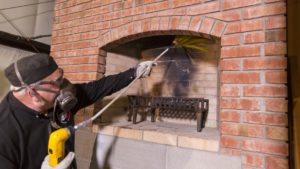 The chimney needs routine inspection and cleaning, especially if you enjoy a crackling fire in your fireplace. Preventing a chimney fire and making sure carbon monoxide isn’t leaking into your home are the aim of having annual chimney inspection. A routine inspection by a professional will prepare you to blockages that can cause smoke problems. Cleaning will remove the buildup of creosote, a smoke residue that condenses and hardens on the inner walls of the chimney flue. The best way to keep your home and family out of harm’s way, yearly inspection and cleaning are the best way.
The chimney needs routine inspection and cleaning, especially if you enjoy a crackling fire in your fireplace. Preventing a chimney fire and making sure carbon monoxide isn’t leaking into your home are the aim of having annual chimney inspection. A routine inspection by a professional will prepare you to blockages that can cause smoke problems. Cleaning will remove the buildup of creosote, a smoke residue that condenses and hardens on the inner walls of the chimney flue. The best way to keep your home and family out of harm’s way, yearly inspection and cleaning are the best way.
The charge about $225 to clean the chimney of a one-story house of a chimney sweep, and it includes the labor and material. Depending on the height of the chimney, the extent of build up in the chimney, and complicating conditions such as a fireplace insert or oddly shaped flue, it may cost even more. You can purchase a chimney brush and rods for about $75 and do the job yourself, pocketing a 66 percent saving. To do this, you’ll need a shop vacuum, some drop cloths to protect the hearth and surrounding furnishings, and an extension ladder. tiny ash particles can filter down into the hearth and be blown around the room, as the chimney is being cleaned up at the roof. In the worse case sometimes, a large chunk of debris or a dead animal can drop down into the hearth.
Fireplace Inspection
Creosote a residue of condensed smoke, is the materials from the result of the removal chimney sweeping. It can cause a chimney to catch fire. In fact, Fire safety officials recommend cleaning chimneys once a year or after every cord of wood burned. Inspecting for damage such as missing mortar or cracked tiles should also be included in a chimney sweep work. Other things that can be included such as chimney sweepers use tarps to cover the hearth and floor around the fireplace and a high-powered vacuum to control dust. If the chimney is less than 35 feet tall, they clean from both the top and the bottom. Inspections are classified as Level 1, Level 2 or Level 3, according to the Chimney Safety Instutite of America. Level 1 is recommended for a chimney under continued service and conditions. An in-depth Level 2 inspection is required when changes are made to the system including fuel type, shape, or relining, or after seismic events, building fires, or sale. When Level 1 or 2 inspections suggest a hidden hazard, Level 3 addresses the proper construction and condition of concealed portions of the structure.
In general, typical costs of the work as follows.
- Sweeping a regular open fireplace can cost $79-$200.
- Cleaning a freestanding wood burning stove with liners runs $109-$209.
- Cleaning wood burning stove inserts with liners is about $109-$149.
- For Do-It-Yourselves, a brush and rod set runs about $20-$30 for a masonry chimney and $29-$36 for a metal chimney. Also helpful are a shop vacuum, ladder, scrubbing brush, safety goggles, stiff scrubbing brush, dust mask and drop cloths.
The additional cost maybe incur such as follows.
- Stove inserts that do not have liners that run to the top of the chimney need to be pulled out for access and run an extra $40-$50. Any insert pipes that have to be removed and cleaned can cost around $20.
- When a camera inspection is used during a cleaning, the cost increases by $10-$300.
- Creosote buildup, an odd-shaped flue, or needed repairs can increase the cost of a chimney sweep.
No need to worry, if you use professional fireplace inspection help to do the job, some companies offer a 10% senior discount and up to $10 off for repeat customers.
